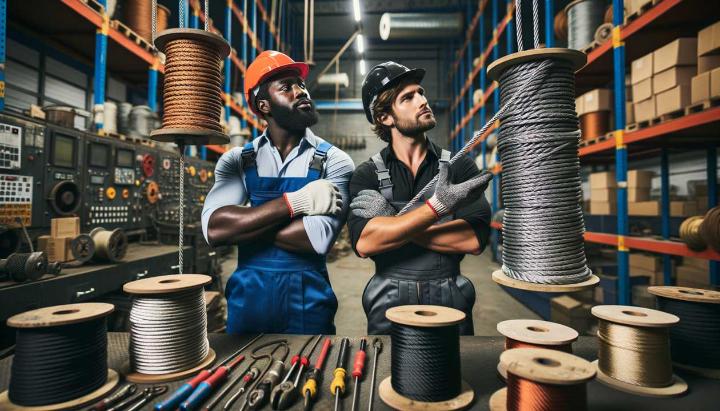Imagine you're an avid rock climber, scaling a towering cliff face with only a slender rope tethering you to safety. As you reach for the next handhold, your heart pounds with adrenaline, but you feel a sense of trust in the rope that supports your every move. That trust is well-placed, thanks to the incredible strength and meticulous engineering behind the fiber rope cradling your weight.
In the world of ropes, steel cables and fiber ropes reign supreme, each offering unique advantages and drawbacks. This blog post delves into the critical aspects of strength, safety, and cost-effectiveness, comparing these two titans of the rope industry. Whether you're an outdoor enthusiast, a construction worker, or an industrial professional, understanding the nuances of these materials can be the difference between success and catastrophe.
While steel cables have long been lauded for their sheer tensile strength, the rise of advanced fiber ropes with wire core has introduced a game-changing blend of strength, flexibility, and lightweight performance. As we explore the depths of this comparison, you'll discover the situations where each type of rope excels, from heavy-duty winch operations to weight-critical aerospace applications.
Comparing Steel Cable and Fiber Rope Strength
When it comes to selecting the right rope or cable for your application, understanding the strength differences between steel cables and fiber ropes is crucial. While both materials have their unique strengths, the choice often comes down to the specific requirements of your project.
Tensile Strength Comparison
Tensile strength is a measure of a material's ability to withstand tension before breaking. In the world of ropes and cables, this metric is paramount. Steel cables, with their rigid construction and metal composition, generally exhibit superior tensile strength compared to fiber ropes of the same diameter. However, the story doesn't end there.
Imagine you're an avid rock climber, and you need a rope that can support your weight and handle the rigors of vertical ascents. Fiber ropes made from ultra-high-molecular-weight polyethylene (HMPE) like Dyneema or aramid fibers can be up to 15 times stronger than steel cables of the same size. These remarkable fibers have revolutionized the industry, offering exceptional strength-to-weight ratios that make them indispensable for demanding applications.

Weight-to-Strength Ratio
While tensile strength is crucial, the weight-to-strength ratio can be just as important, especially in applications where weight is a critical factor. Fiber ropes excel in this area, offering an unbeatable combination of strength and lightness.
Think about it – if you're rigging a sailboat or working on an aerospace project, every ounce counts. Fiber ropes like Dyneema or HMPE can provide the same strength as steel cables while being significantly lighter, reducing the overall weight burden and increasing efficiency. For more detailed comparisons, you can explore the benefits and best uses of synthetic ropes versus steel wire.
But it's not just about weight; fiber ropes also offer enhanced flexibility, making them easier to handle and less prone to kinking or tangling. This flexibility can be a game-changer in tight spaces or complex rigging scenarios, ensuring safer and more efficient operations.
Safety Considerations for Steel Cable and Fiber Rope
When working with ropes and cables, safety should always be the top priority. Both steel cables and fiber ropes pose unique risks that require careful handling, inspection, and maintenance to ensure a secure and reliable setup. Let's dive into the key safety considerations for these two types of ropes.
Inspection and Maintenance of Steel Wire Ropes
Steel cables are susceptible to various factors that can compromise their strength and durability over time. Regular visual inspections are crucial to identify potential hazards such as wear, fatigue, corrosion, or kinks that may weaken the cable's structural integrity.
Here's a quick checklist for inspecting steel wire ropes:
- Look for broken wires or strands – Any protruding or broken wires are a clear sign that the cable needs to be replaced.
- Check for corrosion or rust – Rust can significantly reduce the cable's strength and increase the risk of sudden failure.
- Inspect for kinks, birdcaging, or other deformities – These can create stress points and cause the cable to break unexpectedly.
In addition to regular inspections, proper maintenance practices like lubrication and correct storage can help extend the lifespan of steel cables. Always follow the manufacturer's recommendations for safe working load limits and replacement guidelines.
Safe Use and Handling of Fiber Ropes
While fiber ropes offer exceptional strength and flexibility, they require special care to prevent premature degradation. Abrasion, chemical exposure, and UV radiation are the primary enemies of these ropes, so it's essential to handle them with caution. To understand more about why synthetic ropes often outperform steel cables, you can read our article on synthetic ropes versus steel lifting cables.
Proper handling and storage can significantly extend the lifespan of your fiber ropes.
Here are some tips for safe fiber rope usage:
- Avoid dragging the rope over rough surfaces – This can cause abrasion and weaken the fibers.
- Store ropes away from direct sunlight and chemicals – UV rays and certain chemicals can degrade the rope's strength over time.
- Follow the manufacturer's instructions for inspection and retirement criteria – Regularly check for signs of wear or damage, and replace the rope when necessary.
By following these safety guidelines and adhering to industry standards, you can maximize the performance and longevity of both steel cables and fiber ropes, ensuring a secure and reliable setup for your application.
Understanding Cost-Effectiveness and Value Comparison
In today's world, where healthcare resources are limited, it's crucial to make informed decisions about how we allocate those resources. That's where cost-effectiveness analysis (CEA) comes into play. This powerful tool helps us evaluate the costs and health outcomes of different interventions, ensuring we get the most bang for our buck.
But what exactly is cost-effectiveness analysis, and how does it relate to the concept of value-based healthcare? Let's break it down.
What is Cost-Effectiveness Analysis?
Cost-effectiveness analysis is a systematic process that compares the costs of a healthcare intervention (such as a new drug, medical device, or treatment) with its associated health outcomes or effects. The goal is to determine whether the intervention provides good value for money.
One of the key metrics used in CEA is the incremental cost-effectiveness ratio (ICER). This ratio compares the additional cost of one intervention over another with the additional health benefits it provides. A lower ICER generally indicates a more cost-effective intervention.
To measure health outcomes, CEA often relies on quality-adjusted life years (QALYs) – a metric that combines both the quantity and quality of life years gained from a particular intervention.

Comparing Cost-Effectiveness and Value-Based Healthcare
Value-based healthcare (VBHC) is a broader concept that aligns closely with the principles of cost-effectiveness analysis. VBHC focuses on maximizing the health outcomes achieved per dollar spent, taking into account not just the costs of interventions but also factors like patient satisfaction, quality of life, and long-term sustainability.
While CEA is a specific tool for evaluating the cost-effectiveness of individual interventions, VBHC is a more comprehensive approach that seeks to optimize the entire healthcare system for value. However, CEA can play a crucial role within the VBHC framework by helping to identify and prioritize the most cost-effective interventions.
Imagine you're a healthcare provider considering two different treatments for a particular condition. By conducting a cost-effectiveness analysis, you can determine which treatment offers the best value for money, factoring in both the costs and the projected health outcomes. This information can then inform your decision-making process within a value-based healthcare model, ensuring that you're delivering high-quality care while also being mindful of resource allocation.
In the end, both cost-effectiveness analysis and value-based healthcare share a common goal: to make the most efficient and effective use of our limited healthcare resources, ultimately improving patient outcomes and ensuring a sustainable healthcare system for generations to come. To further explore the cost-effectiveness and advantages of different rope materials, check out the premium quality rope solutions for every industry.
Submit Your Inquiry for Custom Rope Solutions
Choosing between steel cable and fiber rope depends on various factors including strength, safety, and cost. While steel cable boasts superior tensile strength, fiber ropes like HMPE offer an impressive strength-to-weight ratio and greater flexibility. If you're looking at cost-effectiveness, a winch with wire rope often serves as a practical solution for heavy-duty use, whereas a rope with wire core balances strength and flexibility for diverse applications. Additionally, don't overlook the longer lifespan and lower maintenance of fiber ropes. Make sure to fill in the inquiry form above to get your customized rope solution tailored to your specific needs.